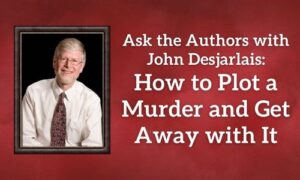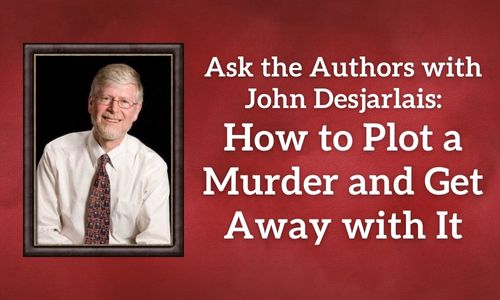 We asked John Desjarlais to discuss his process writing (and plotting) a murder mystery. In these books, everything is important. Characters, settings, interactions, motive—especially motive—all play into whether or not your reader will believe your story.
We asked John Desjarlais to discuss his process writing (and plotting) a murder mystery. In these books, everything is important. Characters, settings, interactions, motive—especially motive—all play into whether or not your reader will believe your story.
Packed with advice on character creation, where ideas come from, and what it takes to put all the moving pieces together to create the mystery that will stick with you, this is a fantastic resource for writers of both mystery and suspense.
Have more questions for our authors? Let us know with a message on Facebook.
How to plot a murder and get away with it!
Plot a murder mystery novel, of course.
Now, even saying “plotting a mystery” suggests that plot is the most important thing. It isn’t. Character is. Plot doesn’t matter if you don’t care about the characters, the people. We tend not to remember plots. We remember people – Sherlock Holmes. Nero Wolfe and Archie Goodwin. Miss Marple. Hercule Poirot. Kinsey Milhone.
Plot is characters in conflict who make choices and change as a result.
Plot is characters in conflict who make choices and change as a result. And if we focus on “plot” as “a cause-and-effect sequence of logical and plausible events which complicate a conflict toward a conclusion,” none of this happens without the people whose choices have consequences leading to the chain of events.
So, while the classic “puzzle” mysteries of Christie, Queen, Marsh, and Dorothy Sayers appear to emphasize plot, where every piece fits logically and necessarily, even ingeniously, we still ask: to whom does it happen? With what motive? With what emotional effect? And thus we are back to character. Bad mysteries impose a plot on puppets. The good mysteries grow out of the lives and struggles of real characters. Is there structure? Yes, and there’s a sample template on my website. Are there rules? Yes, a few, and they’re listed on my website, too. But characters come first.
Find the Rules of the Game and the Classic Mystery Basic Backbone
Well, let me hedge a little. Sometimes the characters don’t come first in the planning of the book. A premise comes first – a “what if”?
In my case, I passed a swine operation’s huge manure lagoon every day on the way to work at a rural college and wondered “What if someone hid a body in the lagoon? What a great place—who would smell it?” And then: “Who would do such a thing,” and then, “Who would have access to it,” and “who would that person hate or fear or feel threatened by so much to see murder as the only option?” And right away I’m talking characters: the villain, and the victim. And who is going to step in and solve this mystery: an amateur with a good reason to get involved, or a professional? A PI or a police officer or team of officers? Now I’m talking about the sleuth. You see, we have moved quickly from premise to people. Three people: Victim, Villain, and Sleuth.
There will be many others, but these 3 people make the story. You will think about them for a long time, perhaps before you commit anything to paper. Strangely, the identity of the killer may not be immediately apparent to you, and it might change as you write the book. “No, it couldn’t be her after all – it was HIM.” If you are surprised, the reader will be surprised, and delighted. But you must make it entirely plausible. The killer for my first mystery changed three times until I figured out who REALLY dunnit.
Let’s consider the 3 main characters in a mystery.
First, the protagonist, the sleuth. The protagonist differs a little by sub-genres: In a “cozy,” it might be a retired widow, in a police procedural, it’s a professional police officer, in the PI story, it’s the gutsy gumshoe like Sam Spade or Kinsey Milhone in her Volkswagen. In the amateur sleuth story it’s an ordinary citizen who is clever and has the time and means to get involved but often gets involved reluctantly. The amateur must have a good reason to get involved: perhaps to clear someone’s name or her own. Sometimes it’s a professional whose job is investigations: an insurance adjustor or TV News reporter. For the private eye or a cop, it’s their job. But at some point, it must become personal. The PI doesn’t need to take on every job. The cop does.
Whoever the protagonist is, this person moves the story, especially if it is a First-Person story. The First-Person story is commonly used since the reader gets to observe only what the sleuth does, but not as keenly, and matches wits with him-or-her to solve the puzzle. The other difference is that the sleuth remembers the little details. Third Person allows more travel and different perspectives; but even then, most Third-Person stories are Third Person Limited, which is still close to the consciousness of the main character. The point-of-view must be chosen early in the process.
The protagonist should be like-able, but not perfect, someone you would want to spend time with – because you will, for about 400 pages – and someone you root for to succeed.
So, the protagonist should be like-able, but not perfect, someone you would want to spend time with – because you will, for about 400 pages – and someone you root for to succeed. This must be someone the reader will care about. How to make the reader (and editor) sympathize? Make him the victim of undeserved suffering or accused of a wrong they didn’t do, put the character in jeopardy, give her relationship problems, a difficult boss, an injury or physical limitation. Make the reader worry about them.
In The Kill Floor, my Detective Sergeant Gordon was a minor character in my previous 3 mysteries. I had to develop him more for a story that was his own. I put him in mid-management in a small town police department with political tensions and a small budget. I had him struggle with the loneliness of his work in a rural area on the economic edge where he has arrested half his high school classmates for something-or-other. His marriage is destabilized by his dangerous work, his odd schedule, his wife’s environmental activism and their problem with fertility.
The protagonist must have the means whereby to solve the puzzle and see that justice is done. The protagonist must be up to the job, with an agile mind, a gift for logic or an insight into people. Auguste Dupin, Sherlock Holmes, and Jacque Futrelle’s “The Thinking Machine” relied on cold logic; Father Brown, Brother Cadfael, and Miss Marple depended on knowing the inner life of people. Detective Sergeant Gordon is a trained cop, and homicide investigations are fairly standardized (providing a convenient initial outline).
To conclude the “protagonist” part: you are going to live with this person a long time, especially if this will be a series, so you’d better like him or her or them.
If you have a sidekick or partner or spouse, be careful about who is going to move the story forward. Hawk never steals the show from Spencer.
Your fictional killer must kill for a reason that he fully justifies to himself.
The Villain, or Killer. This person supplies the central question, WHY. The killer creates the problem. All the questions of the book: who was killed, when, where, how, and most importantly, why – all reside with this person. This person must be really up to the task, a worthy antagonist, often an amateur who must be motivated to kill another human being, and given the opportunity, had the means and did it. It is very difficult to kill another human being, and the motivation must be compelling and completely plausible. I hear that many mysteries are rejected on this one point: lack of strong or believable motivation. In real life, to be sure, people kill for petty, stupid reasons – the wrong shoe color, stumbling into a holdup, and so on. The papers are full of sad stories. But your fictional killer must kill for a reason that he fully justifies to himself. The villain is the hero of his own story. The scariest villains are ordinary people who have been pushed to the edge – Hannibal Lector notwithstanding. It isn’t enough to say a person is psychotic, even in serial killer stories. They are usually smart—and desperate. Killing someone was the only solution they could imagine for their problem.
Do not put off meeting the villain. Beginners delay this meeting, afraid they will give away the identity. If you introduce a few people who had reason to dislike the victim, enough doubt will be sown. In a “thriller,” however, the bad guy is usually known early, and we know how dangerous he is. A “thriller” is a good guy, a bad guy, and a ticking clock. In a mystery, however, we do not know the killer until the end, and even though we are smart, we are surprised, and delightfully so. So bring the killer into the story early, not late, and not just as a walk-on.
The victim is a person, with a history and a personality, and people left behind grieving.
The Victim. The victim cannot be simply the body in the library at the opening. The victim is more than a corpse. The victim is a person, with a history and a personality, and people left behind grieving. The victim is the reason the protagonist gets involved at all.
There are 2 different kinds of victims in mysteries.
The “despicable victim” is the person everyone loathed, the person of whom everyone said, “He’s gonna get himself killed.” Then it happens, and any number of people had a good reason to do it. This approach provides lots of suspects, and it helps to flesh out the broad middle of a book. Christie liked this approach, and it allows many “red herrings,” as many people have a motive, means, and opportunity, and something to hide (but no one has all four). This is true in The Kill Floor, where everyone in town hated the brash and exploitative CEO of the huge swine operation.
The “sympathetic victim” is someone the reader and protagonist both like. A reader will identify with, and root for, the sleuth’s quest for answers and for justice. The victim deserves this dignity.
Secondary characters. Minor characters perform a number of functions in the plot.
First, they reveal things about your main character, since who your friends are says a lot about you, right? The way they respond to the main character says a lot about him, the way they talk about each other is revealing, too. They are a foil, a sounding board, and above all, a source for a subplot that somehow mirrors the main plot or develops a theme. Family members and co-workers are good for this.
In terms of mystery plotting, though, minor characters are two other things: information providers and suspects. Some are walk-ons: librarians, cashiers, cab drivers, clergy, dog walkers. Some have information but can’t talk much for legal reasons, like lawyers, nurses, and bank tellers. In the broad middle of the book, the sleuth will meet many people who will assist him in the hunt to answer “whodunit”? and some will be suspects. Give these people personalities and problems, too. They drink too much, they struggle to live on a pension, they’re addicted to pain-killers, they’re in debt, they have wayward kids, they’re losing their faith, their farm, their health.
These are the people who will help your sleuth get through the broad middle of the book. He goes to person A and asks a question. A’s reluctance to answer sends him to B. B is found to be living with C who used to be married to A. C hurries out with a folder of documents with a clear label on it, D’s office, so the sleuth visits D. D brushes him off and says You need to talk to A. And so on. Give some of these people a temporary reason to be suspicious. Give just about everyone a secret, but ultimately, only one of them had the motive, and means, and opportunity to kill, and maybe kill again to cover it up, and who might possibly kill the sleuth who is getting too close to the terrible truth.
OK.
You have your main characters: sleuth, victim, villain. From this, you can begin to build your novel.
First, there are some writers who mull things over a while and then start typing, from beginning to end. The first draft is, for them, a very long outline. For such writers, the real work takes place after this draft – filling in plot holes, rounding out characters, planting clues, maybe even some cut-and-paste work – literally- with scissors and tape.
Others, like me, do a lot of work before the first drafting begins. This requires a methodical bent, a step-by-step approach that delays passion in favor of precision. I do a lot of research and make many lists and use calendars and maps.
It’s messy. I start by ‘webbing,’ starting with Victim/Villain/Sleuth/Suspects/Cast and branching out-literally-from there (try googling ‘webbing’ and you’ll see some examples though they’re usually for nonfiction). My diagram looks like a wheel with spokes and sometimes like a tree with many branches. “Villain” might stay blank if I’m not sure. But I’ll start organizing along these ‘spokes’ or ‘branches’, jotting down what I know and what I need to find out.
The next step is the good ol’fashioned outline. Not the Roman numeral “I” followed by A, B, C, but a kind of list. Mysteries tend to follow a regular pattern of development, so it helped me to organize the messy ‘spoke’ details according to the “Template” on my website. Another useful “outline’ is Joseph Campbell’s “The Hero’s Journey” especially for an amateur sleuth story. If you aim for 15 chapters of 15 or 20 pages each, you’ll end up with a book. There ought to be a discovery or excitement at every third chapter or so.
But a book is actually constructed with scenes, not ‘chapters.’ Scenes are discrete units of action in a single setting with a POV character and a beginning, middle, and end that often has a discovery, reversal, or a decision. Aim for 45-50 scenes: 25% for the hook and setup, 50% for the middle build of discoveries and setbacks, and 25% for the payoff, and these will be short and page-turning.
Sometimes chapters become scenes, not whole chapters. That’s ok. Outlines change, too, especially in the “Middle Game.” But if you have the “opening Gambit” and have a good idea of the “Endgame,” it’s just a matter of doggedly getting there and being patient with yourself.
What all this means, in conclusion, is that the process, over time, becomes more and more detailed. Webbing and listing lead to a tentative “block” or chapter outline or just a list of this-needs-to-happen in order to begin seeing the story’s shape, informed by biographies of characters you might make, background research, and various notes on cards.
Writing a book is a marathon. You will hit “the wall,” as runners call it, around chapter 11. If you have the outlines (yes, you’ll probably have more than one), you will maintain your vision. You must finish the book. A half-finished book is no book at all.
Good luck! Remember, you’ll find “Rules of the Game” and a sample outline template at my website, www.johndesjarlais.com in the section called “Writing.”
 A former producer for Wisconsin Public Radio, John Desjarlais taught English for 25 years at Kishwaukee College (IL). His novels include The Throne of Tara (Crossway 1990), The Light of Tara (KDP 2020), Relics (Thomas Nelson 1993), Bleeder, Viper, Specter (Chesterton Press, 2008, 2011, 2015), and The Kill Floor (Torchflame Books 2022). His short stories and poems have appeared in literary journals such as The Critic, Conclave, Lit Noir, and Dappled Things. A member of Mystery Writers of America and The North Carolina Writers Network, he is listed in Who’s Who in Entertainment and Who’s Who Among America’s Teachers. He is a graduate of the writing program at Illinois State University and the Writers Police Academy. He resides in Hendersonville, NC. Connect with John at johndesjarlais.com.
A former producer for Wisconsin Public Radio, John Desjarlais taught English for 25 years at Kishwaukee College (IL). His novels include The Throne of Tara (Crossway 1990), The Light of Tara (KDP 2020), Relics (Thomas Nelson 1993), Bleeder, Viper, Specter (Chesterton Press, 2008, 2011, 2015), and The Kill Floor (Torchflame Books 2022). His short stories and poems have appeared in literary journals such as The Critic, Conclave, Lit Noir, and Dappled Things. A member of Mystery Writers of America and The North Carolina Writers Network, he is listed in Who’s Who in Entertainment and Who’s Who Among America’s Teachers. He is a graduate of the writing program at Illinois State University and the Writers Police Academy. He resides in Hendersonville, NC. Connect with John at johndesjarlais.com.

